height OPEL MANTA 1973 Service Manual
[x] Cancel search | Manufacturer: OPEL, Model Year: 1973, Model line: MANTA, Model: OPEL MANTA 1973Pages: 625, PDF Size: 17.22 MB
Page 147 of 625
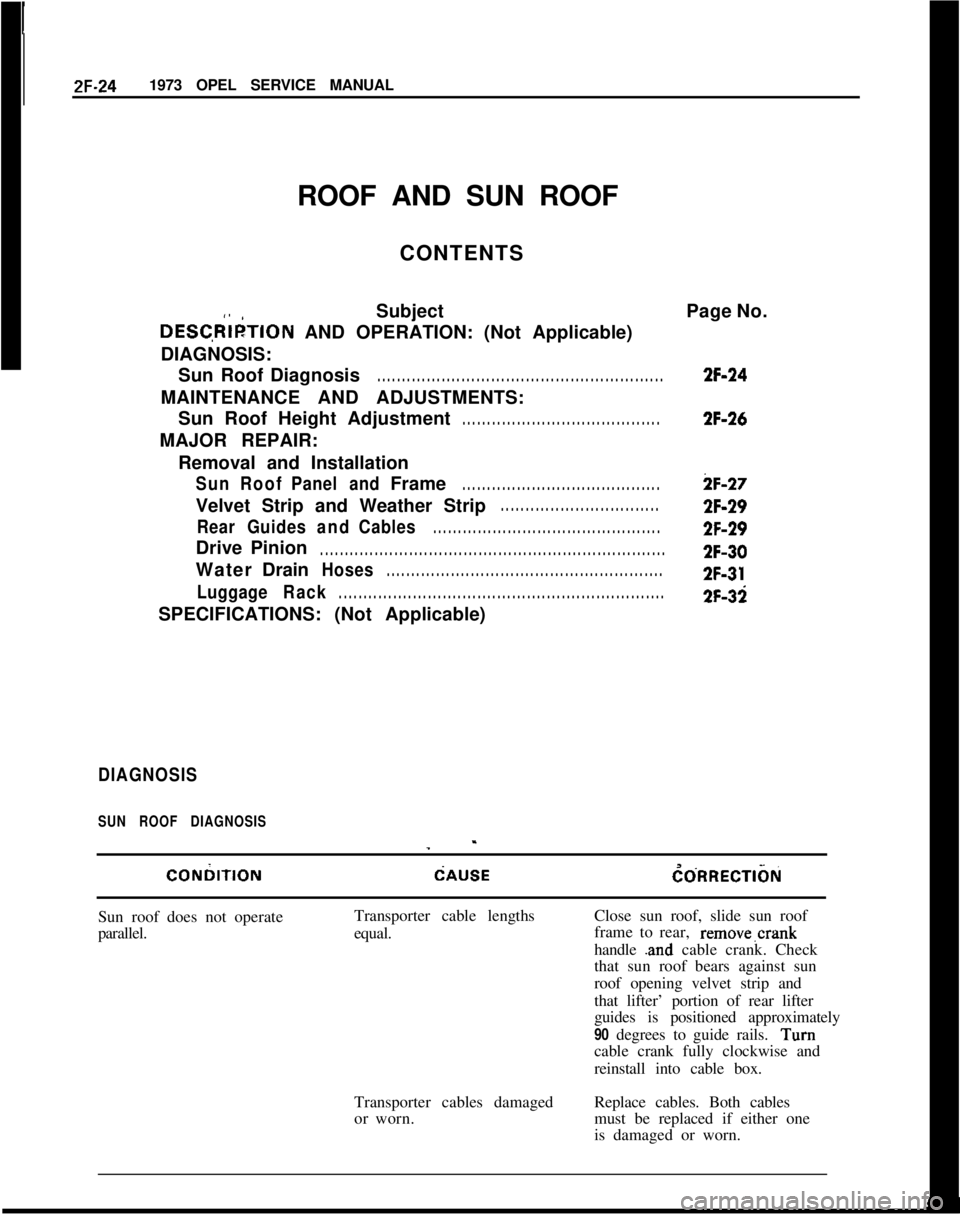
2F-241973 OPEL SERVICE MANUAL
ROOF AND SUN ROOF
CONTENTS
,.,Subject
DESC,RIF?TION AND OPERATION: (Not Applicable)
DIAGNOSIS: Sun Roof Diagnosis
. . . . . . . . . . . . . . . . . . . . . . . . . . . . . . . . . . . . \
. . . . . . . . . . . . . . . . . . . . . .
MAINTENANCE AND ADJUSTMENTS:Sun Roof Height Adjustment
. . . . . . . . . . . . . . . . . . . . . . . . . . . . . . . . . . . . \
. . . .
MAJOR REPAIR:
Removal and Installation
Sun Roof Panel andFrame. . . . . . . . . . . . . . . . . . . . . . . . . . . . . . . . . . . . \
. . . .
Velvet Strip and Weather Strip. . . . . . . . . . . . . . . . . . . . . . . . . . . . . . . .
RearGuides andCables. . . . . . . . . . . . . . . . . . . . . . . . . . . . . . . . . . . . \
. . . . . . . . . .
Drive Pinion. . . . . . . . . . . . . . . . . . . . . . . . . . . . . . . . . . . . \
. . . . . . . . . . . . . . . . . . . . . . . . . . . . . . . . . .
Water DrainHoses. . . . . . . . . . . . . . . . . . . . . . . . . . . . . . . . . . . . \
. . . . . . . . . . . . . . . . . . . .
Luggage Rack. . . . . . . . . . . . . . . . . . . . . . . . . . . . . . . . . . . . \
. . . . . . . . . . . . . . . . . . . . . . . . . . . . . .
SPECIFICATIONS: (Not Applicable) Page No.
2F-24
2F-26
iF-27
2F-29
2F-29
2F-30
2F-31
2F-3i
DIAGNOSIS
SUN ROOF DIAGNOSIS
_ -
CONhTlONPAUSEI~C~RRECTI~X~
Sun roof does not operate
Transporter cable lengths
parallel. equal.Close sun roof, slide sun roof
frame to rear, remove.crank
handle
and cable crank. Check
that sun roof bears against sun
roof opening velvet strip and
that lifter’ portion of rear lifter
guides is positioned approximately
90 degrees to guide rails.
Turn
cable crank fully clockwise and
reinstall into cable box.
Transporter cables damaged
or worn. Replace cables. Both cables
must be replaced if either one
is damaged or worn.
Page 148 of 625
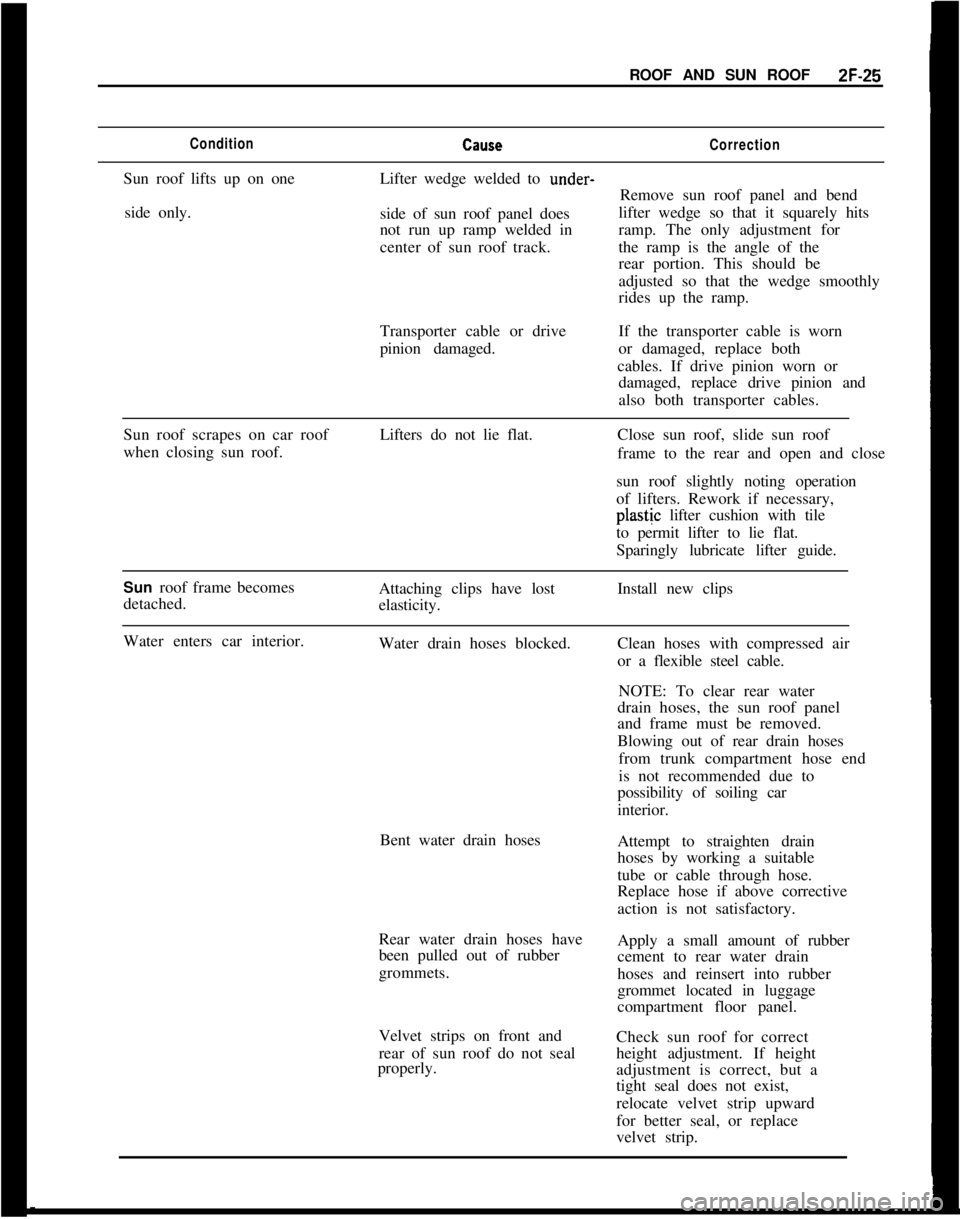
ROOF AND SUN ROOFZF-25ConditionCallseCorrectionSun roof lifts up on one
side only.Lifter wedge welded to under-
Remove sun roof panel and bend
side of sun roof panel doeslifter wedge so that it squarely hits
not run up ramp welded inramp. The only adjustment for
center of sun roof track.the ramp is the angle of the
rear portion. This should be
adjusted so that the wedge smoothly
rides up the ramp.
Transporter cable or drive
pinion damaged.If the transporter cable is worn
or damaged, replace both
cables. If drive pinion worn or
damaged, replace drive pinion and
also both transporter cables.
Sun roof scrapes on car roof
when closing sun roof.Lifters do not lie flat.Close sun roof, slide sun roof
frame to the rear and open and close
sun roof slightly noting operation
of lifters. Rework if necessary,plastjc lifter cushion with tile
to permit lifter to lie flat.
Sparingly lubricate lifter guide.
Sun roof frame becomes
detached.Attaching clips have lost
elasticity.Install new clips
Water enters car interior.
Water drain hoses blocked.
Bent water drain hoses
Rear water drain hoses have
been pulled out of rubber
grommets.
Velvet strips on front and
rear of sun roof do not seal
properly.Clean hoses with compressed air
or a flexible steel cable.
NOTE: To clear rear water
drain hoses, the sun roof panel
and frame must be removed.
Blowing out of rear drain hoses
from trunk compartment hose end
is not recommended due to
possibility of soiling car
interior.
Attempt to straighten drain
hoses by working a suitable
tube or cable through hose.
Replace hose if above corrective
action is not satisfactory.
Apply a small amount of rubber
cement to rear water drain
hoses and reinsert into rubber
grommet located in luggage
compartment floor panel.
Check sun roof for correct
height adjustment. If height
adjustment is correct, but a
tight seal does not exist,
relocate velvet strip upward
for better seal, or replace
velvet strip.
Page 149 of 625
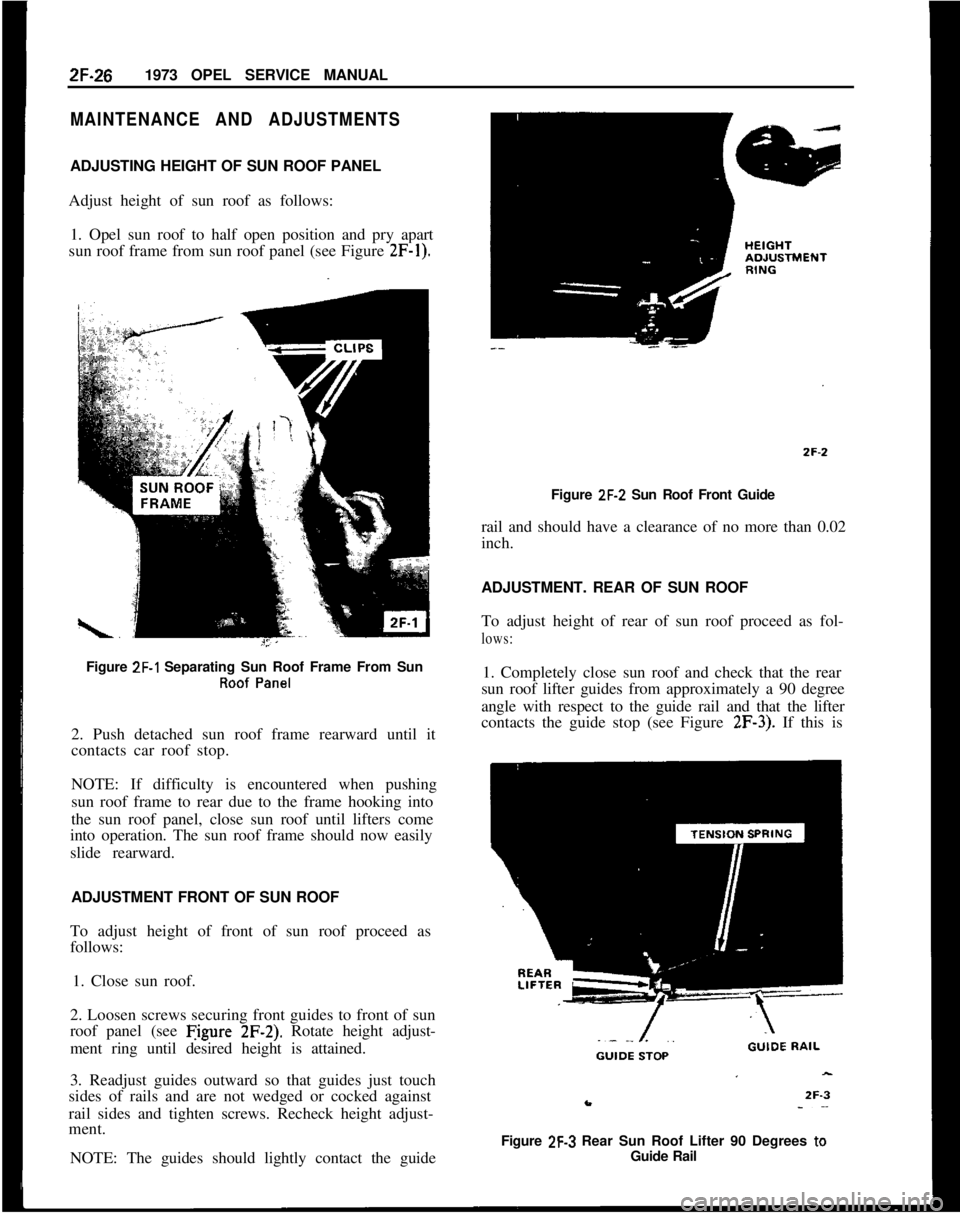
2F-261973 OPEL SERVICE MANUALMAINTENANCE AND ADJUSTMENTSADJUSTING HEIGHT OF SUN ROOF PANEL
Adjust height of sun roof as follows:
1. Opel sun roof to half open position and pry apart
sun roof frame from sun roof panel (see Figure
2F-1).Figure
ZF-1 Separating Sun Roof Frame From SunRoof Panel2. Push detached sun roof frame rearward until it
contacts car roof stop.
NOTE: If difficulty is encountered when pushing
sun roof frame to rear due to the frame hooking into
the sun roof panel, close sun roof until lifters come
into operation. The sun roof frame should now easily
slide rearward.
ADJUSTMENT FRONT OF SUN ROOF
To adjust height of front of sun roof proceed as
follows:
1. Close sun roof.
2. Loosen screws securing front guides to front of sun
roof panel (see Figure
2F-2). Rotate height adjust-
ment ring until desired height is attained.
3. Readjust guides outward so that guides just touch
sides of rails and are not wedged or cocked against
rail sides and tighten screws. Recheck height adjust-
ment.
NOTE: The guides should lightly contact the guideFigure
ZF-2 Sun Roof Front Guide
rail and should have a clearance of no more than 0.02
inch.
ADJUSTMENT. REAR OF SUN ROOF
To adjust height of rear of sun roof proceed as fol-
lows:1. Completely close sun roof and check that the rear
sun roof lifter guides from approximately a 90 degree
angle with respect to the guide rail and that the lifter
contacts the guide stop (see Figure
2F-3). If this is
Figure
2F-3 Rear Sun Roof Lifter 90 Degrees toGuide Rail
Page 151 of 625
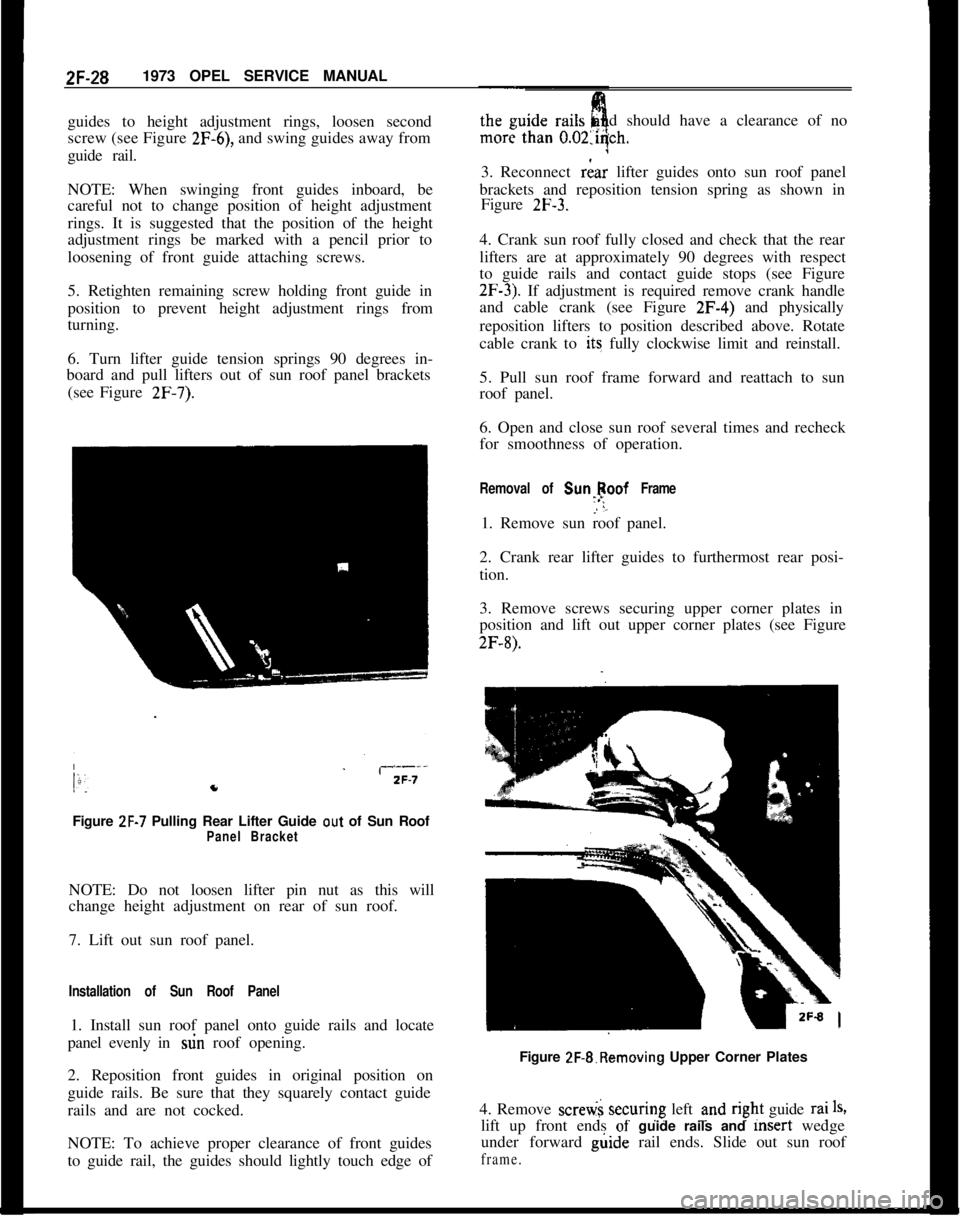
2F-281973 OPEL SERVICE MANUAL
guides to height adjustment rings, loosen second
screw (see Figure 2F-6), and swing guides away from
guide rail.
NOTE: When swinging front guides inboard, be
careful not to change position of height adjustment
rings. It is suggested that the position of the height
adjustment rings be marked with a pencil prior to
loosening of front guide attaching screws.
5. Retighten remaining screw holding front guide in
position to prevent height adjustment rings from
turning.
6. Turn lifter guide tension springs 90 degrees in-
board and pull lifters out of sun roof panel brackets
(see Figure
2F-7).Figure
ZF-7 Pulling Rear Lifter Guide out of Sun RoofPanel BracketNOTE: Do not loosen lifter pin nut as this will
change height adjustment on rear of sun roof.
7. Lift out sun roof panel.
Installation of Sun Roof Panel1. Install sun roof panel onto guide rails and locate
panel evenly in stin roof opening.
2. Reposition front guides in original position on
guide rails. Be sure that they squarely contact guide
rails and are not cocked.
NOTE: To achieve proper clearance of front guides
to guide rail, the guides should lightly touch edge ofdshould have a clearance of no
3. Reconnect
riar lifter guides onto sun roof panel
brackets and reposition tension spring as shown in
Figure
2F-3.4. Crank sun roof fully closed and check that the rear
lifters are at approximately 90 degrees with respect
to guide rails and contact guide stops (see Figure
2F-3). If adjustment is required remove crank handle
and cable crank (see Figure 2F-4) and physically
reposition lifters to position described above. Rotate
cable crank to its fully clockwise limit and reinstall.
5. Pull sun roof frame forward and reattach to sun
roof panel.
6. Open and close sun roof several times and recheck
for smoothness of operation.
Removal of Sunlpoof Frame1. Remove sun roof panel.
2. Crank rear lifter guides to furthermost rear posi-
tion.
3. Remove screws securing upper corner plates in
position and lift out upper corner plates (see Figure
2F-8).Figure 2F-&Removing Upper Corner Plates
4. Remove scretii securing left und
r@t guide rai1%lift up front ends
of- guide rails and msert wedge
under forward g&de rail ends. Slide out sun roof
frame.
Page 193 of 625
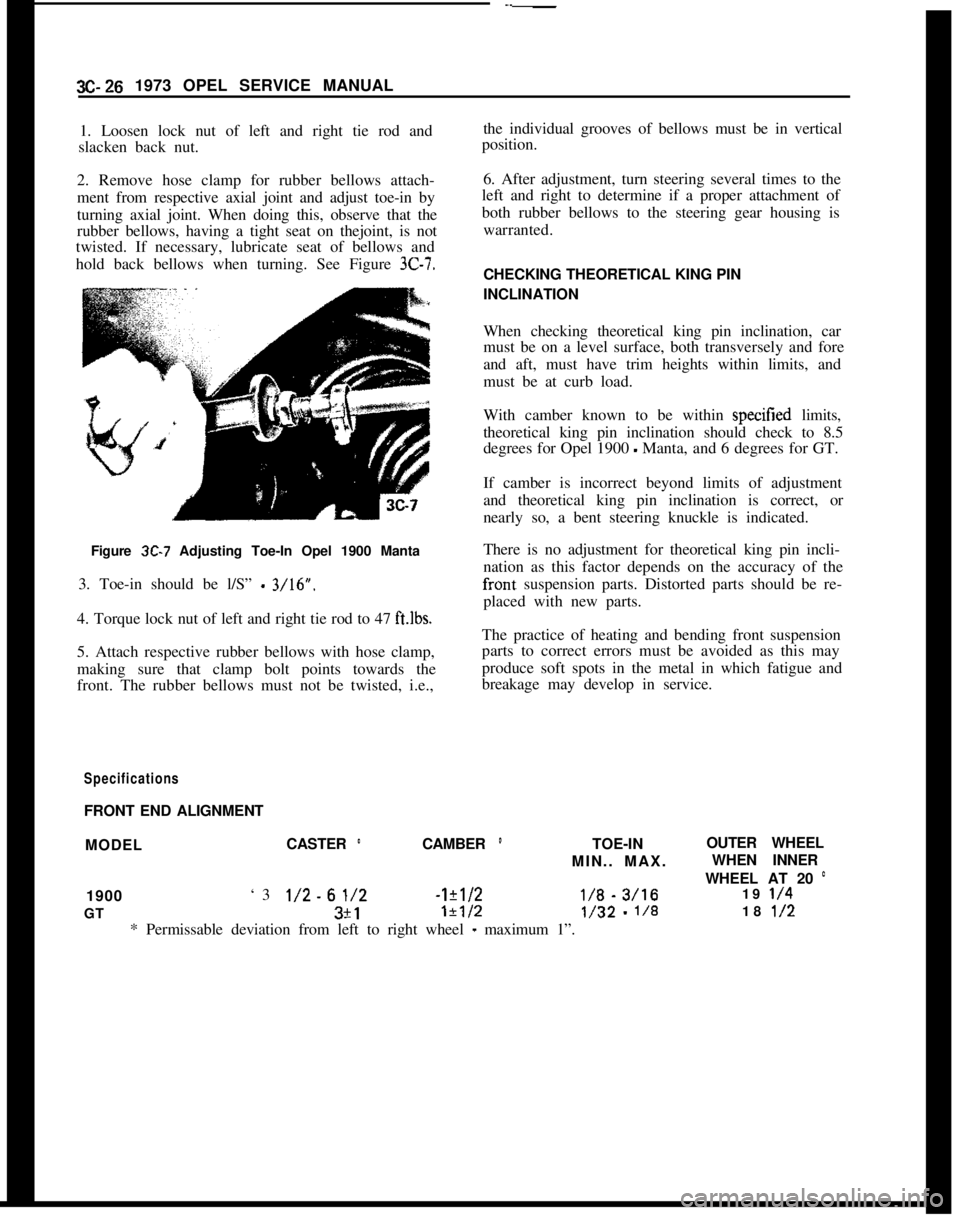
3C-26 1973 OPEL SERVICE MANUAL
1. Loosen lock nut of left and right tie rod and
slacken back nut.
2. Remove hose clamp for rubber bellows attach-
ment from respective axial joint and adjust toe-in by
turning axial joint. When doing this, observe that the
rubber bellows, having a tight seat on thejoint, is not
twisted. If necessary, lubricate seat of bellows and
hold back bellows when turning. See Figure 3C-7.Figure
3C-7 Adjusting Toe-In Opel 1900 Manta
3. Toe-in should be l/S”
- 3/16”.
4. Torque lock nut of left and right tie rod to 47
ft.lbs.5. Attach respective rubber bellows with hose clamp,
making sure that clamp bolt points towards the
front. The rubber bellows must not be twisted, i.e.,
SpecificationsFRONT END ALIGNMENTthe individual grooves of bellows must be in vertical
position.
6. After adjustment, turn steering several times to the
left and right to determine if a proper attachment of
both rubber bellows to the steering gear housing is
warranted.
CHECKING THEORETICAL KING PIN
INCLINATION
When checking theoretical king pin inclination, car
must be on a level surface, both transversely and fore
and aft, must have trim heights within limits, and
must be at curb load.
With camber known to be within specitied limits,
theoretical king pin inclination should check to 8.5
degrees for Opel 1900
- Manta, and 6 degrees for GT.
If camber is incorrect beyond limits of adjustment
and theoretical king pin inclination is correct, or
nearly so, a bent steering knuckle is indicated.
There is no adjustment for theoretical king pin incli-
nation as this factor depends on the accuracy of the
fronts suspension parts. Distorted parts should be re-
placed with new parts.
The practice of heating and bending front suspension
parts to correct errors must be avoided as this may
produce soft spots in the metal in which fatigue and
breakage may develop in service.
MODELCASTER
’CAMBER ’TOE-INOUTER WHEEL
MIN.. MAX.WHEN INNER
WHEEL AT 20
’1900‘3
l/2-61/2-1?1/2I/% - 3/1619 l/4GT3+1
1+1/2l/32 - l/818 l/2* Permissable deviation from left to right wheel
- maximum 1”.
Page 220 of 625
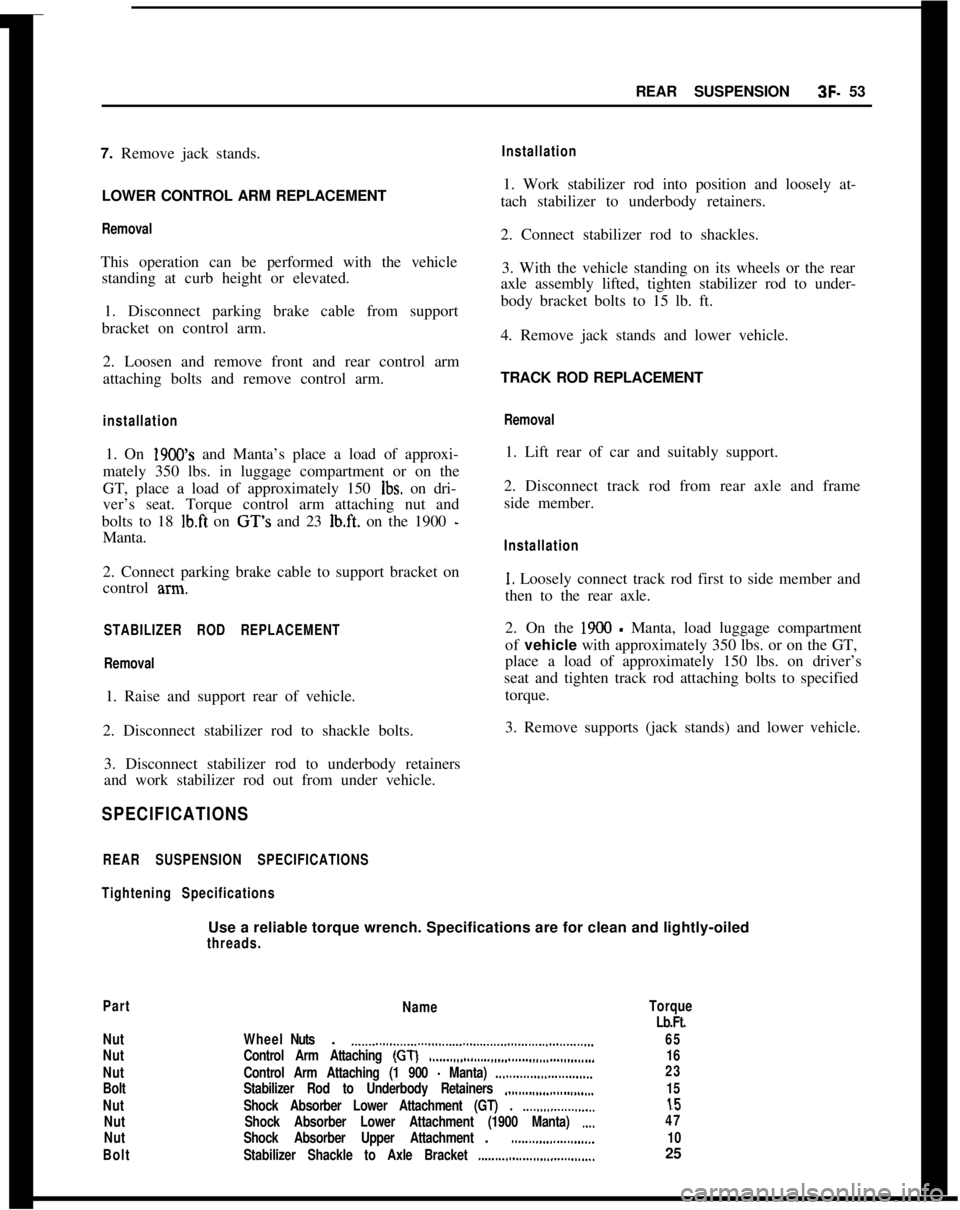
REAR SUSPENSION3F- 53
7. Remove jack stands.
LOWER CONTROL ARM REPLACEMENTRemovalThis operation can be performed with the vehicle
standing at curb height or elevated.
1. Disconnect parking brake cable from support
bracket on control arm.
2. Loosen and remove front and rear control arm
attaching bolts and remove control arm.
installation1. On
1900’s and Manta’s place a load of approxi-
mately 350 lbs. in luggage compartment or on the
GT, place a load of approximately 150
Ibs. on dri-
ver’s seat. Torque control arm attaching nut and
bolts to 18 lb.ft on
GT’s and 23 Ib.ft. on the 1900 -Manta.
2. Connect parking brake cable to support bracket on
control
ranI.
STABILIZER ROD REPLACEMENT
Removal1. Raise and support rear of vehicle.
2. Disconnect stabilizer rod to shackle bolts.
3. Disconnect stabilizer rod to underbody retainers
and work stabilizer rod out from under vehicle.
SPECIFICATIONS
REAR SUSPENSION SPECIFICATIONS
Tightening SpecificationsInstallation1. Work stabilizer rod into position and loosely at-
tach stabilizer to underbody retainers.
2. Connect stabilizer rod to shackles.
3. With the vehicle standing on its wheels or the rear
axle assembly lifted, tighten stabilizer rod to under-
body bracket bolts to 15 lb. ft.
4. Remove jack stands and lower vehicle.
TRACK ROD REPLACEMENT
Removal1. Lift rear of car and suitably support.
2. Disconnect track rod from rear axle and frame
side member.
Installation
1. Loosely connect track rod first to side member and
then to the rear axle.
2. On the
1900 - Manta, load luggage compartment
of vehicle with approximately 350 lbs. or on the GT,
place a load of approximately 150 lbs. on driver’s
seat and tighten track rod attaching bolts to specified
torque.
3. Remove supports (jack stands) and lower vehicle.
Use a reliable torque wrench. Specifications are for clean and lightly-oiled
threads.
Part
Nut
Nut
Nut
Bolt
Nut
Nut
Nut
BoltName
WheelNuts.
.._.._......._........................................................
Control Arm Attaching (GT) .._.._.,,,........,,.,,.......,,......,,,,......
Control Arm Attaching (1 900 - Manta) .,,...._...,,,,_.....,,.,...
Stabilizer Rod to Underbody Retainers ,....._.,.,,.,.....,,,....
Shock Absorber Lower Attachment (GT) . .._.....,._.._.,,,...
Shock Absorber Lower Attachment (1900 Manta) ,,.,
Shock Absorber Upper Attachment. .._.....................
Stabilizer Shackle to Axle Bracket .._._.._,...._..,,.,,.......,,,...
Torque
Lb.Ft.
65
16
23
15
1,5
47
1025
Page 245 of 625
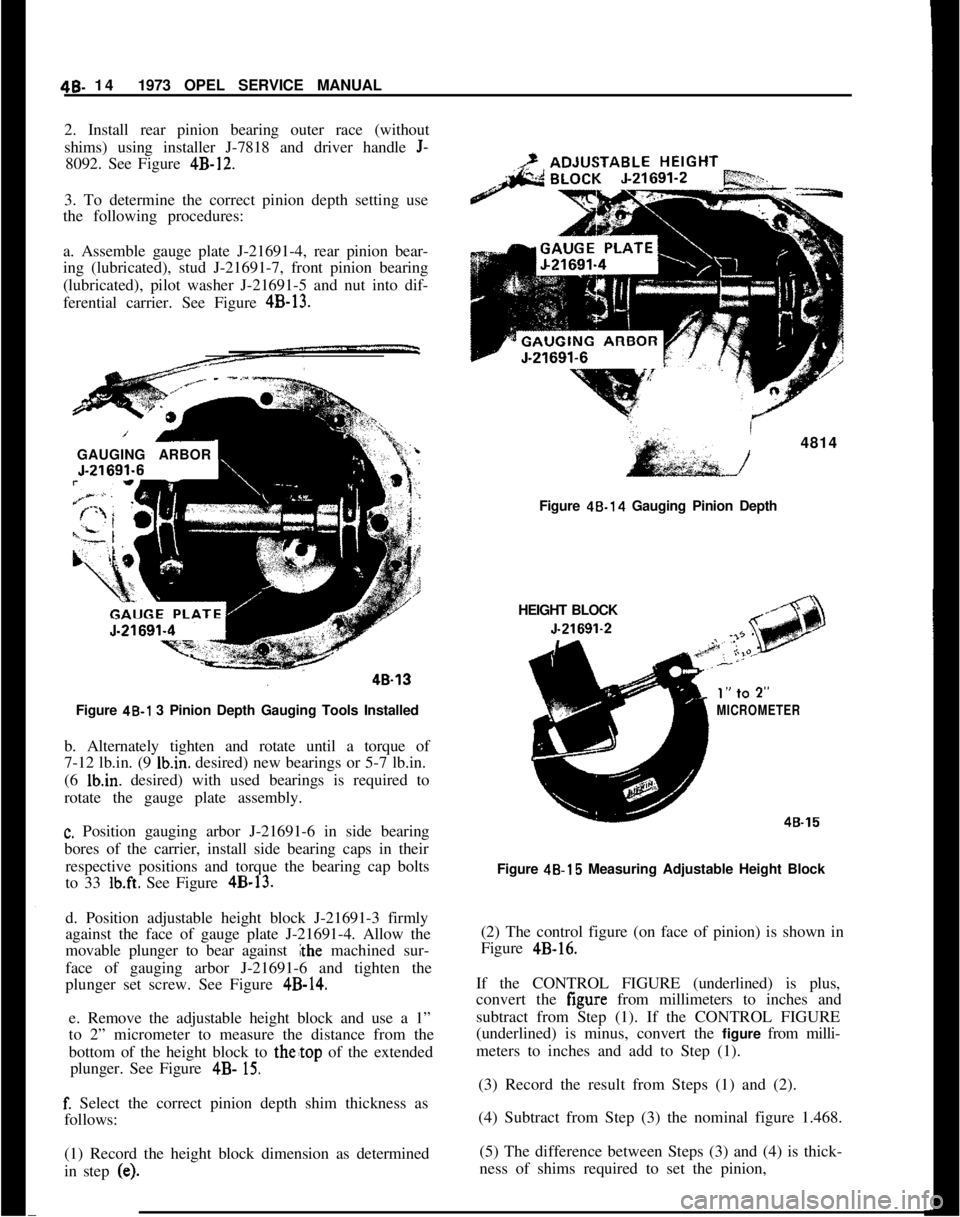
46. 141973 OPEL SERVICE MANUAL
2. Install rear pinion bearing outer race (without
shims) using installer J-7818 and driver handle
J-8092. See Figure 4B-12.
3. To determine the correct pinion depth setting use
the following procedures:
a. Assemble gauge plate J-21691-4, rear pinion bear-
ing (lubricated), stud J-21691-7, front pinion bearing
(lubricated), pilot washer J-21691-5 and nut into dif-
ferential carrier. See Figure 4B-13.
‘1GAUGING ARBOR
Figure 48-l 3 Pinion Depth Gauging Tools Installed
b. Alternately tighten and rotate until a torque of
7-12 lb.in. (9 Ibin. desired) new bearings or 5-7 lb.in.
(6 lb.in. desired) with used bearings is required to
rotate the gauge plate assembly.
c. Position gauging arbor J-21691-6 in side bearing
bores of the carrier, install side bearing caps in their
respective positions and torque the bearing cap bolts
to 33
lb.ft. See Figure 4B-13.
d. Position adjustable height block J-21691-3 firmly
against the face of gauge plate J-21691-4. Allow the
movable plunger to bear against
#the machined sur-
face of gauging arbor J-21691-6 and tighten the
plunger set screw. See Figure
4B-14.e. Remove the adjustable height block and use a 1”
to 2” micrometer to measure the distance from the
bottom of the height block to
thetop of the extended
plunger. See Figure
4B- 15.
f. Select the correct pinion depth shim thickness as
follows:
(1) Record the height block dimension as determined
in step
(e).
I4814
/Figure 48.14 Gauging Pinion Depth
HEIGHT BLOCK
MICROMETER
48-15Figure 4B-15 Measuring Adjustable Height Block
(2) The control figure (on face of pinion) is shown in
Figure
4B-16.If the CONTROL FIGURE (underlined) is plus,
convert the figure from millimeters to inches and
subtract from Step (1). If the CONTROL FIGURE
(underlined) is minus, convert the figure from milli-
meters to inches and add to Step (1).
(3) Record the result from Steps (1) and (2).
(4) Subtract from Step (3) the nominal figure 1.468.
(5) The difference between Steps (3) and (4) is thick-
ness of shims required to set the pinion,
Page 246 of 625
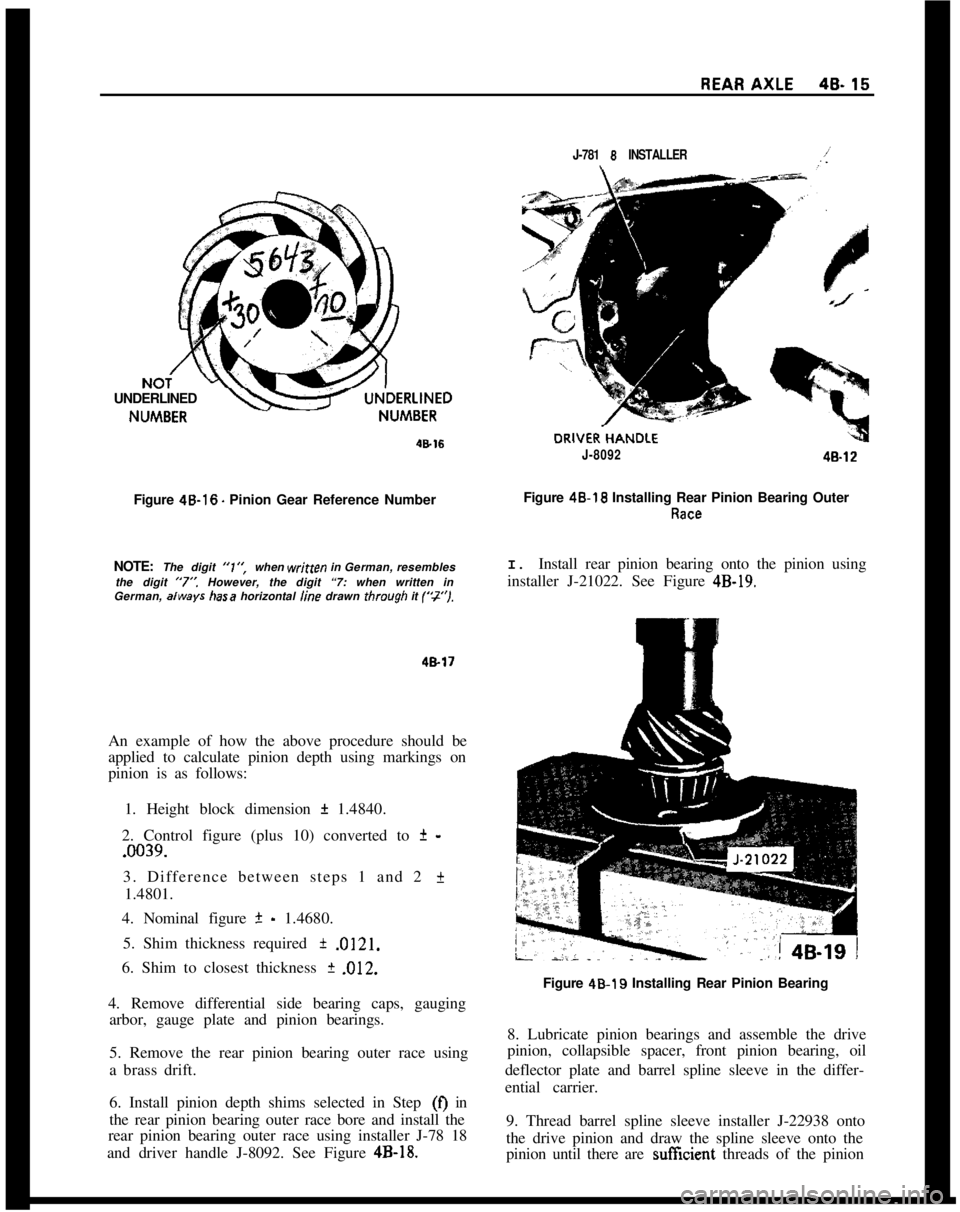
J-781 B INSTALLERiUNDERLINED
4B16Figure 46-16
- Pinion Gear Reference Number
NOTE: The digit “1’:when written in German, resembles
the digit
“7, However, the digit “7: when written in
German, always hasa horizontal line drawn rhrough it ,‘Z”).
4&17An example of how the above procedure should be
applied to calculate pinion depth using markings on
pinion is as follows:
1. Height block dimension
+ 1.4840.
2. Control figure (plus 10) converted to
f -.0039.
3. Difference between steps 1 and 2 it
1.4801.
4. Nominal figure
2 - 1.4680.
5. Shim thickness required
?r .0121.
6. Shim to closest thickness
+ .012.
4. Remove differential side bearing caps, gauging
arbor, gauge plate and pinion bearings.
5. Remove the rear pinion bearing outer race using
a brass drift.
6. Install pinion depth shims selected in Step
(f) in
the rear pinion bearing outer race bore and install the
rear pinion bearing outer race using installer J-78 18
and driver handle J-8092. See Figure 4B-18.
DRIVER.HANDLE
J-8092
48-12Figure 48.18 Installing Rear Pinion Bearing Outer
RaceI. Install rear pinion bearing onto the pinion using
installer J-21022. See Figure
4B-19.Figure 4B-19 Installing Rear Pinion Bearing
8. Lubricate pinion bearings and assemble the drive
pinion, collapsible spacer, front pinion bearing, oil
deflector plate and barrel spline sleeve in the differ-
ential carrier.
9. Thread barrel spline sleeve installer J-22938 onto
the drive pinion and draw the spline sleeve onto the
pinion until there are suflicient threads of the pinion
Page 283 of 625
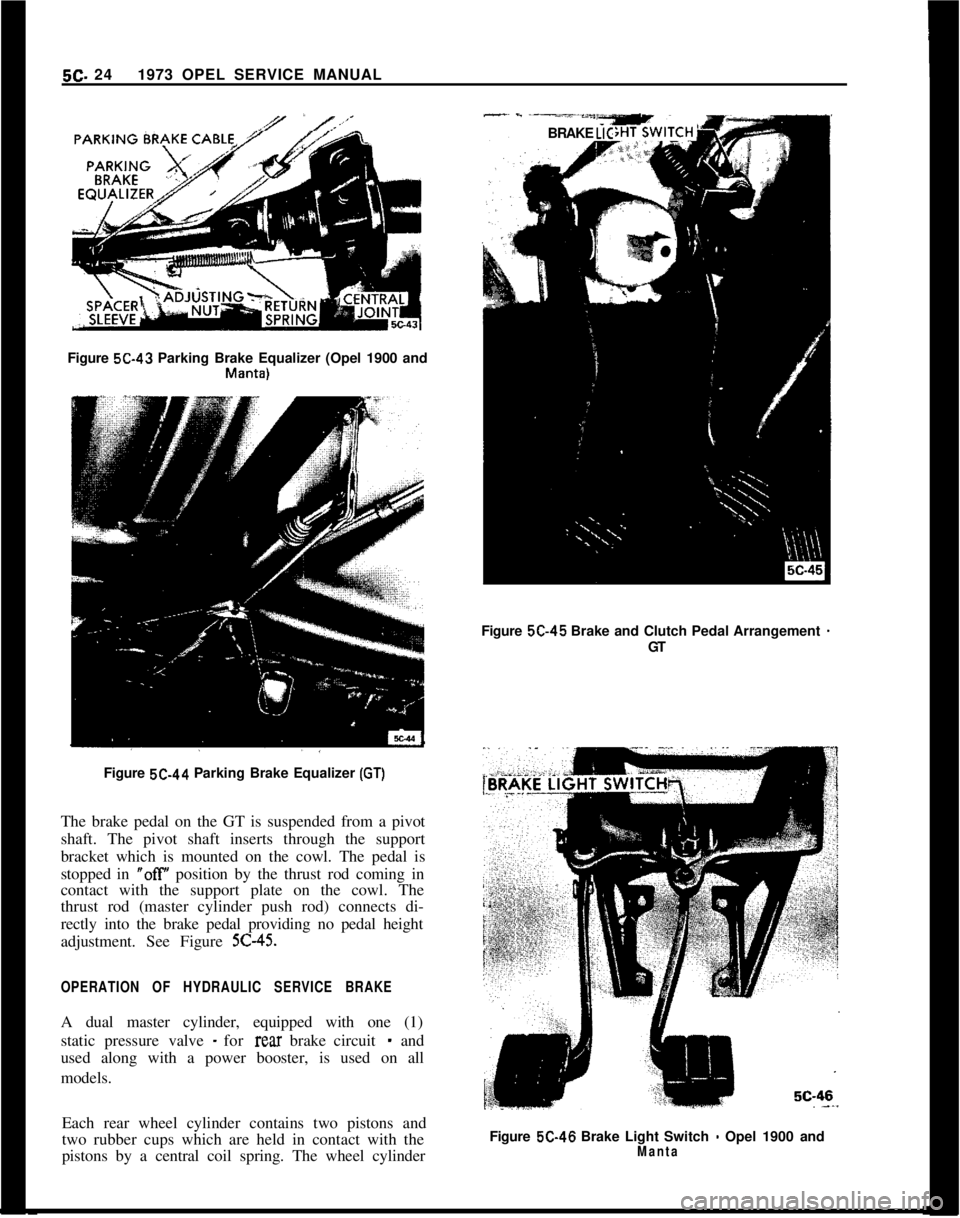
5C- 241973 OPEL SERVICE MANUAL-~ - -----*““YBRAKE LICFigure 5C-43 Parking Brake Equalizer (Opel 1900 and
Mallta)Figure 5C-45 Brake and Clutch Pedal Arrangement
-GT
Figure 5C-44 Parking Brake Equalizer
(GT)The brake pedal on the GT is suspended from a pivot
shaft. The pivot shaft inserts through the support
bracket which is mounted on the cowl. The pedal is
stopped in
“off position by the thrust rod coming in
contact with the support plate on the cowl. The
thrust rod (master cylinder push rod) connects di-
rectly into the brake pedal providing no pedal height
adjustment. See Figure
5C-45.
OPERATION OF HYDRAULIC SERVICE BRAKEA dual master cylinder, equipped with one (1)
static pressure valve
- for rear brake circuit - and
used along with a power booster, is used on all
models.
Each rear wheel cylinder contains two pistons and
two rubber cups which are held in contact with the
pistons by a central coil spring. The wheel cylinderFigure 5C-46 Brake Light Switch
- Opel 1900 andManta
Page 286 of 625

DRUM BRAKES5C- 27MAINTENANCE AND ADJUSTMENTSBRAKE ADJUSTMENT
Preliminary Checks
1. Depress brake pedal firmly. If pedal travels to
within two inches of toeboard and has a hard feel,
brake shoes require adjustment or relining. However,
if pedal has a spongy feel, brake system needs bleed-
ing.2. Remove one rear drum if lining is worn nearly to
rivets. Reline both rear brakes (drum brakes only).
3. Check fluid level in master cylinder reservoir and
add fluid if necessary.
4. Fully release parking brake lever and place trans-
mission in neutral.
5. Pull on both ends of rear brake cable a number of
times to make sure that cables operate rear brake
shoes freely and do not bind in conduits. Check for
free movement of cable in brake cable sheave and
check brake cable spring for tension. Replace a weak
or broken cable spring.
Pedal Height Adjustment
Brake pedal height can be adjusted by first removing
the nut and lock tab from the brake pedal to clevis
attaching bolt and then by turning the head of the
bolt and rotating the eccentric until there is approxi-
mately
l/4 of an inch play in the brake pedal. See
Figures
X-49 and 5C-50. Replace lock tap and nut.
If one of the tabs on lock tap breaks replace lock tab.5c49
Figure 5C-49 Brake Pedal Attaching Bolt and
EccentricFigure 5C-50 Brake Pedal Height Adjustment
If binding does occur, take pedal assembly apart and
clean. Check for broken parts. Lubricate and replace.
Adjustment at Wheels
At each rear wheel brake assembly there are two (2)
brake shoes, and each brake shoe has an individual
adjustment eccentric. Therefore, each shoe must be
adjusted separately by turning its adjustment
ccccn-tric which is mounted on the brake backing plate.
Arrows on backing plate circumference show direc-
tion in which eccentrics should be turned to get
brake shoe-to-drum contact. See Figure X-51.
When adjusting front brake shoe ofrear brakes, turn
wheel forward. When adjusting rear brake shoe of
rear wheel brakes, turn wheel rearward. Adjust as
folio ws:1. Raise car and support in a safe manner so that all
wheels clear ground. Prior to wheel brake adjust-
ment, check that all brake drums rotate freely.
2. Revolve drum in forward direction and turn front
brake shoe eccentric in direction of arrow until brake
shoe contacts brake drum. See Figure
5C-49, then
turn eccentric in opposite direction until brake drum
is just free to turn. Adjust rear brake shoe in the same
way but revolve brake drum in backward direction.
3. Remove car jacking and support equipment, and
road test car for brake performance.
Disc brakes do not require adjustment.
Parking Brake Adjustment
Adjustment of parking brake cable is necessary
whenever the rear brake cables have been